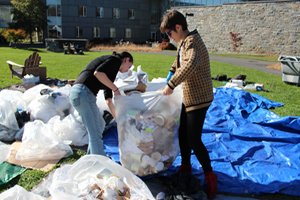Students Raise Sustainability Awareness with Surprise Trash Audit

Students walking toward the Science Center on a Wednesday morning earlier this month were witnesses to an unusual sight: bags and bags of garbage strewn on the lawn. Like all things at Swarthmore, however, the bags were there for an educational purpose, as the Swarthmore College Green Advisors were conducting a surprise trash audit of both Kohlberg Hall and the Science Center.
The Green Advisors are Swarthmore students committed to facilitating sustainability on campus. They worked in conjunction with Environmental Services (EVS), the Grounds and Horticulture Department, and the Sustainability Committee to conduct the audit, a process used to quantify the amount and type of trash being generated and exactly how it is being disposed. By conducting an audit of two of the College's most high-trafficked buildings, the Green Advisors hoped to bring awareness to the way in which the community uses its recycling and compost systems, to pinpoint what leaves a building as waste, and what materials could have been recycled or composted.
The night before the event, EVS staff took bags of trash from these buildings to tarps on the lawn between Kohlberg and the Science Center instead of to dumpsters. The next day, shifts of students, faculty, and staff sorted the waste into categories so that they could be analyzed and weighed.
"The Green Advisors wanted to make a visual statement that displayed the sheer amount of waste and cross-contamination, in order to spark a behavioral change in the student body," says Erin Ching '16, a Seattle native.
The audit produced some intriguing results. Of everything thrown in the trash, only 37 percent of it is actually considered garbage. The rest could have been recycled or composted. Of everything that can be composted, only 7.6 percent of it is actually put in the compost.
Laura Laderman '15, a physics major from San Francisco, Calif. and one of the event organizers, is not surprised by the numbers. "They are similar to what I might have predicted just from observing student behavior," she says.
According to Kelley Langhans '16 from San Mateo, Calif., another Green Advisor, the group "wanted to raise awareness about the amount of waste we could divert from being burned in Chester." All waste from Delaware County, including that from Swarthmore's campus, is taken to Chester, Pa., to be incinerated. Correct composting and recycling systems can help reduce the amount of trash incinerated in Chester, which would benefit the Chester community and the environment.
The Green Advisors hope that the results of this trash audit inspire awareness and change. Moving forward, the group plans on making their own changes on campus, including a reorganization of trash receptacles and better labeling of trash, recycling, and compost bins. The audit also served as an initial baseline measurement of cross-contamination on the campus that the Green Advisors can use moving forward in facilitating sustainability on campus.


